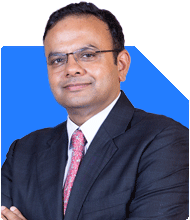Ramalingam Kalirajan |10908 Answers |Ask -Follow
Mutual Funds, Financial Planning Expert - Answered on Jun 20, 2025
He has an MBA in finance from the University of Madras and is a certified financial planner.
He is the director and chief financial planner at Holistic Investment, a Chennai-based firm that offers financial planning and wealth management advice.... more

Q1. How to select good liquid mutual funds. Can you suggest any? And are they also regular/direct ?? Q2. My HDFC account which I am planning to keep will have 10k minimum amount limit once it gets converted to saving account (now salary acc but after joining SBI it will become saving) so how to manage that??
Liquid mutual funds are meant for short-term parking of money. They are low-risk and low-return.
They usually invest in treasury bills, commercial papers, and short-duration debt instruments.
But all liquid funds are not the same. Some key points must be checked.
Look for low modified duration. Ideally, less than 91 days.
Ensure that the fund does not take credit risk. It must hold top-rated instruments.
Check for a low expense ratio. It should be below 0.40% in a regular plan.
Look for an AMC with stable debt performance and zero past defaults.
See if the fund follows a conservative investment policy. Avoid aggressive debt funds.
Daily or weekly liquidity is a must. Ensure they offer easy redemption without exit load.
The fund size must be large enough. This gives better stability during redemptions.
Choose a fund with consistent past return, not the highest return. Stability is key.
How Much Should Be Parked in Liquid Funds?
Liquid funds are meant for short-term and emergency money.
For emergency fund, park 3 to 6 months of full expenses in liquid funds.
For money needed in less than 12 months, use liquid or ultra-short term debt funds.
Do not invest in equity funds for short-term needs. Equity is volatile in short durations.
Even when you wait to invest in lump sum into equity, park that amount in liquid fund.
For SIPs in mutual funds, if cash is parked for 1–3 months, use liquid funds instead of savings account.
Direct vs Regular Liquid Funds
Liquid funds come in both direct and regular options.
Let’s compare them carefully. Especially in your case, where quality advice matters.
Direct Funds
You must do all research, selection, monitoring, and switching yourself.
You save on distributor commission, but take full risk if something goes wrong.
No emotional handholding or tax-related planning.
Very risky if you are not reviewing portfolios monthly or quarterly.
Regular Funds (Through MFD + CFP)
You get advice, curation, alerts, and regular fund tracking support.
SIPs are managed better, asset allocation is guided, tax-loss harvesting is possible.
Certified Financial Planner understands your overall goals and links each investment properly.
For a small extra cost, you get peace of mind and a strategy that adapts with time.
For someone building a family corpus or preparing for PG studies, mistakes in timing can be costly.
So, always choose regular funds through an MFD backed by a Certified Financial Planner.
This is not just for liquid funds, but for all categories — large cap, flexi cap, or debt.
How to Use Liquid Fund in Real Life Scenarios
Many people confuse emergency fund with fixed deposit. Liquid funds are better.
Let’s look at how you can practically use liquid funds.
Emergency buffer: Keep at least Rs 3–4 lakhs in a liquid fund. Link it to a sweep-in FD if needed.
Insurance premium: If you pay Rs 30,000 per month in insurance, that’s Rs 3.6 lakhs per year. You can park this in liquid fund, and redeem quarterly.
Upcoming school/college expenses: If a big bill is coming in 3–6 months, use liquid fund.
Home down payment or repair cost: Keep money in liquid fund till decision is finalised.
SIP Buffer: In case of job change or transfer, use liquid fund to continue SIPs without pausing.
Do not keep these funds in savings account. Savings account earns low return, usually 2.5–3.5%.
HDFC Bank Account Conversion After Salary Stops
You mentioned your HDFC account is currently salary-linked. After job switch, it will convert into a savings account.
The concern is around the minimum balance requirement. Let’s break this down.
Once it becomes a regular savings account, you must maintain Rs 10,000 minimum monthly balance.
If balance falls below this limit, non-maintenance charges apply. These can be Rs 300–Rs 600 monthly.
You can avoid penalty in three ways:
Maintain minimum balance by keeping at least Rs 10,000 parked in that account.
Convert this account into a Basic Savings Bank Deposit Account (BSBDA). Then there is no minimum balance rule.
Alternatively, close this account and transfer all activity to your new SBI account.
HDFC may offer zero balance savings account also. But benefits are limited.
If you want to keep this account for any ECS, SIP, or auto-debit, then maintain Rs 10,000 as minimum idle balance.
If no such linkage exists, it is better to close it and reduce operational clutter.
How to Link Liquid Fund to Bank Account
Many investors don’t know that they can link liquid funds to savings account through a simple process.
Some AMCs offer Insta Redemption Facility. You can redeem up to Rs 50,000 instantly to your account.
The process takes less than 30 minutes. Operates on all working days.
Choose AMCs that have mobile apps with instant redemption option.
You can also use STP (Systematic Transfer Plan) from liquid fund to equity fund gradually.
This reduces risk of investing lump sum in volatile markets.
For example, if you plan to invest Rs 5 lakhs into equity, first park in liquid fund. Then use STP over 6–12 months.
Mistakes to Avoid While Using Liquid Funds
Even low-risk funds need careful handling. Avoid these common mistakes.
Investing in unknown or very high return liquid funds. They may be taking credit risk.
Using direct plans without tracking NAVs and credit quality.
Keeping emergency money in savings account or cash at home.
Redeeming liquid fund for impulsive spending. Keep it strictly tagged to real goals.
Treating liquid fund as long-term investment. It is not suitable for 3+ years horizon.
Ignoring tax impact. Though liquid fund is taxed as per slab, plan redemptions wisely.
Liquid Fund Taxation Rules
Taxation on liquid mutual funds has changed recently.
Liquid funds are considered debt funds.
No indexation benefit available from April 2023.
Whether held for short term or long term, gains are taxed as per income tax slab.
So, if your slab is 30%, the gains are taxed at 30%, regardless of holding period.
Returns are still better than savings accounts. But taxation must be planned.
Do not invest too much in one fund. Diversify across 2–3 AMC liquid funds if amount is large.
Final Insights
Liquid funds are a powerful tool for disciplined and flexible money management.
They help you separate long-term investments from short-term needs. They give better returns than bank accounts. And they allow safe, timely access to funds when needed.
Choose liquid funds with low risk and high transparency. Don’t chase return in liquid funds. Prioritise safety and access.
Always invest through regular plans via a Certified Financial Planner and MFD. Do not go the direct route, especially for short-term goals and emergency buffer.
Keep minimum required balance in bank accounts only where needed. Else, reduce unused accounts. Keep things simple and easy to manage.
Use liquid funds smartly. Keep money moving with purpose. Let no rupee lie idle.
This will make your overall portfolio more efficient and future-ready.
Best Regards,
K. Ramalingam, MBA, CFP,
Chief Financial Planner,
www.holisticinvestment.in
https://www.youtube.com/@HolisticInvestment
You may like to see similar questions and answers below
Abhishek Dev | Answer |Ask -Follow
Financial Planner - Answered on Aug 16, 2023
Ramalingam Kalirajan |10908 Answers |Ask -Follow
Mutual Funds, Financial Planning Expert - Answered on Aug 21, 2024
Ramalingam Kalirajan |10908 Answers |Ask -Follow
Mutual Funds, Financial Planning Expert - Answered on May 25, 2024
Ramalingam Kalirajan |10908 Answers |Ask -Follow
Mutual Funds, Financial Planning Expert - Answered on Jan 30, 2025
Ramalingam Kalirajan |10908 Answers |Ask -Follow
Mutual Funds, Financial Planning Expert - Answered on Dec 20, 2025
Ramalingam Kalirajan |10908 Answers |Ask -Follow
Mutual Funds, Financial Planning Expert - Answered on Dec 20, 2025
Naveenn Kummar |237 Answers |Ask -Follow
Financial Planner, MF, Insurance Expert - Answered on Dec 20, 2025
Ramalingam Kalirajan |10908 Answers |Ask -Follow
Mutual Funds, Financial Planning Expert - Answered on Dec 19, 2025
Nayagam P P |10859 Answers |Ask -Follow
Career Counsellor - Answered on Dec 19, 2025
Ramalingam Kalirajan |10908 Answers |Ask -Follow
Mutual Funds, Financial Planning Expert - Answered on Dec 19, 2025
Ramalingam Kalirajan |10908 Answers |Ask -Follow
Mutual Funds, Financial Planning Expert - Answered on Dec 19, 2025
Ramalingam Kalirajan |10908 Answers |Ask -Follow
Mutual Funds, Financial Planning Expert - Answered on Dec 19, 2025
Radheshyam Zanwar |6751 Answers |Ask -Follow
MHT-CET, IIT-JEE, NEET-UG Expert - Answered on Dec 19, 2025
Radheshyam Zanwar |6751 Answers |Ask -Follow
MHT-CET, IIT-JEE, NEET-UG Expert - Answered on Dec 19, 2025























